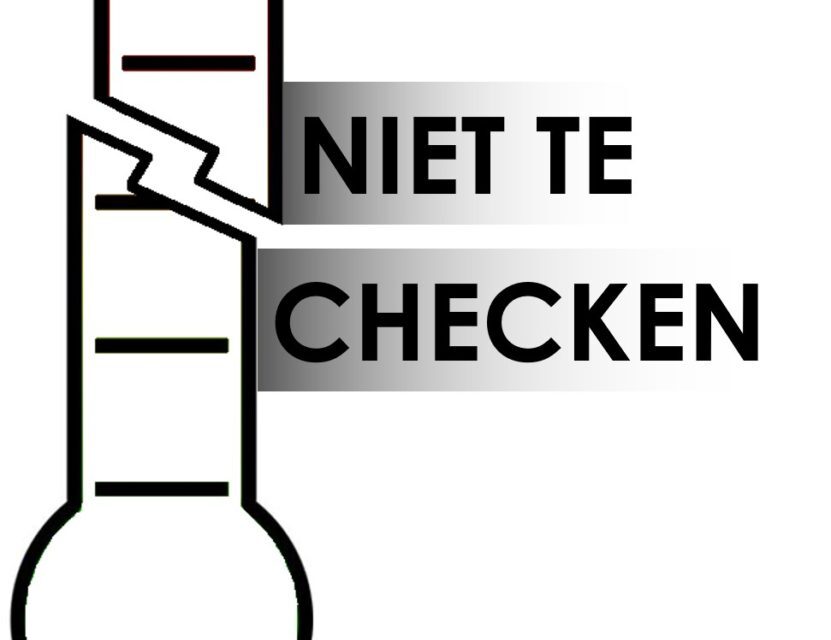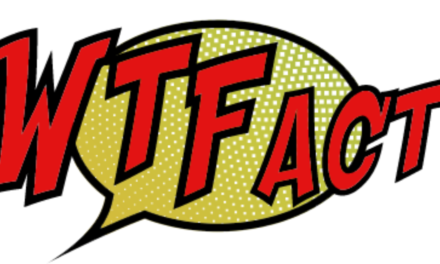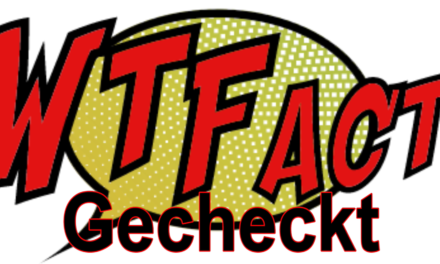In the first national election debate, broadcasted by RTL4, leaders of political parties in the Netherlands were asked to take a stance on several important issues. One of the statements, about climate change was: “In order to achieve the climate goals the Netherlands must build new nuclear power plants”. Conservativeparties such as the VVD (liberal party), the PVV (nationalist party) and the CDA (Christian democrats) voted in favor. The progressive parties voted against the statement. When asked to explain their view GroenLinks (green party) leader Jesse Klaver claimed that nuclear energy, as a solution for fossil energy, is the biggest lie in this election. He also claimed that nuclear energy will not help achieve the climate goals from the Paris treaty.
The Paris Agreement
The Paris Agreement is a legally binding international treaty against climate change. The accord was adopted by 196 Parties at COP 21, on 12 December 2015 and put into action on 4 November 2016 (United Nations). One of the goals in the accord is to limit global warming to well below 2 degrees, preferably to 1.5 degrees Celsius. To achieve this long-term temperature goal, countries aim to reach global peaking of greenhouse gas emissions as soon as possible to achieve a climate neutral world by mid-century (United Nations).
“The Paris Agreement is a landmark in the multilateral climate change process because, for the first time, a binding agreement brings all nations into a common cause to undertake ambitious efforts to combat climate change and adapt its effects.” (United Nations)
Nuclear power plants across the globe
Nuclear power plants produce no greenhouse gas emissions during operation. During its life cycle a nuclear power plant produces about the same amount of carbon dioxide-equivalent emissions per unit of electricity as wind, and one-third of the emissions per unit of electricity when compared with solar (World Nuclear Association).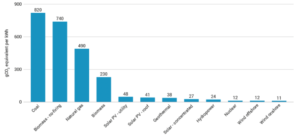
Average life-cycle carbon dioxide-equivalent emissions for different electricity generators (Source: IPCC)
Since April 2020, there are 440 operable power reactors in the world, with a combined electrical capacity of 390 GW. Additionally, there are 55 reactors under construction and 109 reactors planned, with a combined capacity of 63 GW and 118 GW. Respectively there are 329 more reactors proposed (World Nuclear Association).
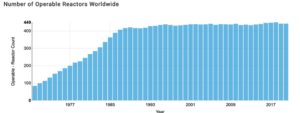
Source: World Nuclear Association
Across the European Union are 106 nuclear power reactors (104 GWe) operating in 13 of the 27 EU member states that account for over one-quarter of the electricity generated in the whole of the EU. Over half of the EU’s nuclear electricity is produced in only one country – France. The 57 units operating in three non-EU countries (Russia, Ukraine and Switzerland) account for about 15-20% of the electricity in the rest of Europe. Norway and Switzerland are effectively part of the EU synchronous grid ( World Nuclear Association).
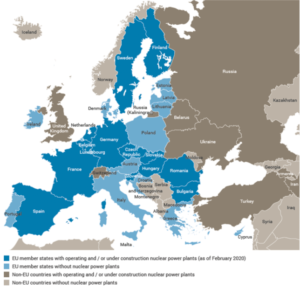
Source: World Nuclear Association.
The role of a nuclear power plant in fighting climate change
Nuclear power, which currently means energy derived from fission (splitting the uranium atom), has a minima carbon footprint of around the 15-50g CO2/KWh. In comparison the average footprint of gas as energy source, is around 450g CO2/KWh. According to these numbers, using nuclear power can be a good way to reduce the carbon footprint and achieve the climate goals. Also, according to the International Energy Agency (IEA), nuclear energy currently contributes to the prevention of CO2 emission of about 1.3 to 2.6 gigatons each year, assuming it replaces either gas-or coal-fired generation (World Nuclear Association).
Besides that, one kilogram of uranium (U235) generates almost 23 million kWh of electricity: enough to provide nearly seven thousand households with electricity for a year. About 30 percent of the energy contained in uranium is converted into electricity (efficiency). According to GroenLinks (green party) this is no reason to invest in nuclear power plants. In an email, the party explained their position as follows: “Uranium, which is used for nuclear power generation, will run out over time. Whereas we can always count on wind and solar energy”. Another argument for nuclear energy, which is used quite often, is that nuclear energy provides investment opportunities and jobs and the basis for economic security in communities that host nuclear plants.
Nuclear power plants as an alternative source of energy
The politic parties that are against nuclear power and believe that it’s not contributing to the CO2 emissions, are also wondering if nuclear power plants are a feasible option to reduce fossil fuel and help to achieve the goals of the Paris Climate Agreement. Their most used argument is that building a nuclear power plant takes a long time and will cost billions of euros. Besides that, the construction costs of nuclear power plants depend on many different determinants such as: design revisions during construction, large plant size and complex large-scale technology, lack of standardization, serialization and modularization, plant safety and environmental concerns, prevention of accidents and risks. These possible cost determinants (see table 1) can influence the construction time of Power Plants (PWRs) and are classified in three general groups: technical, regulatory, and institutional (Construction time of Power Plants PWRs).
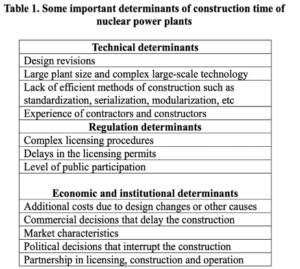
Figure 2: Construction time of PWRs
During 1980 and 2000 the time for building a nuclear power plant was 92 months or 7.7 years with a maximum of 10 years. Nowadays building a nuclear power plant will take 41 months, still almost 4 years, due to innovation. Lots of goals are aimed at 2050 (mid-century), that is only 30 years from now. We will have 25 years from the moment the nuclear plant is operational, is that enough? According to the Nuclear Energy Agency of the OECD, yes. Modern nuclear power plants can very well do the absorb variations in the supply of sustainable sources. Nuclear power plants adjust between 50 and 100% power at a rate of 5% per minute. For example, nuclear energy in France has been providing for forty years adjustable CO2-neutral electricity, 24 hours per day, seven days a week (Nuclear energy is needed to achieve the climate goals).
It will take renewed attention and a sense of urgency across the world to stimulate a new wave of nuclear investments. The use of nuclear energy for electricity generation is a political minefield at every level. Beyond technological problems, it is politics that is the biggest obstacle to the more widespread adoption of nuclear energy (Clingendael Spector).
Advantages and disadvantages of a nuclear power plant
Another argument against nuclear power is radioactive waste. Opponents of nuclear energy consider this as one of the most important arguments. There is not yet a good way to store or process it. For example, in the Netherlands nuclear power has been stored in the southern province Zeeland. The low to medium radioactive waste is stored in a bunker. Poured into concrete, in order to limit the radiation as much as possible. The highly radioactive waste is stored in another bunker, also poured into concrete and stored in iron tubes. Because radioactive waste does not decay and remains on earth for thousands of years, storage is no long-term solution.
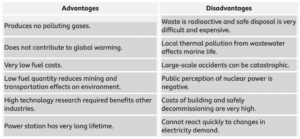
Figure 3: Nuclear power
Conclusion
With the statement “Nuclear energy is the biggest lie in this election”, Klaver expresses his opinion that nuclear energy is not the answer to a zero-emissions future “we do not have time, it is not sustainable, and we can better spend the money on more future-proof solutions, which will also benefit the coming generations,” he argued. However nuclear energy as a solution to reduce CO2-emissions is not inherently a “lie”, as Klaver states. Supporters of nuclear energy rightfully point at the low CO2-emissions. But if it will prove to be a solution for meeting the climate goals in the Paris agreement is a very complicated issue. Klavers statement is as much a prediction as the position of the supporters of nuclear power. And therefore uncheckable.
